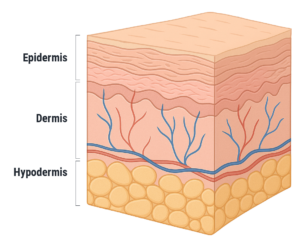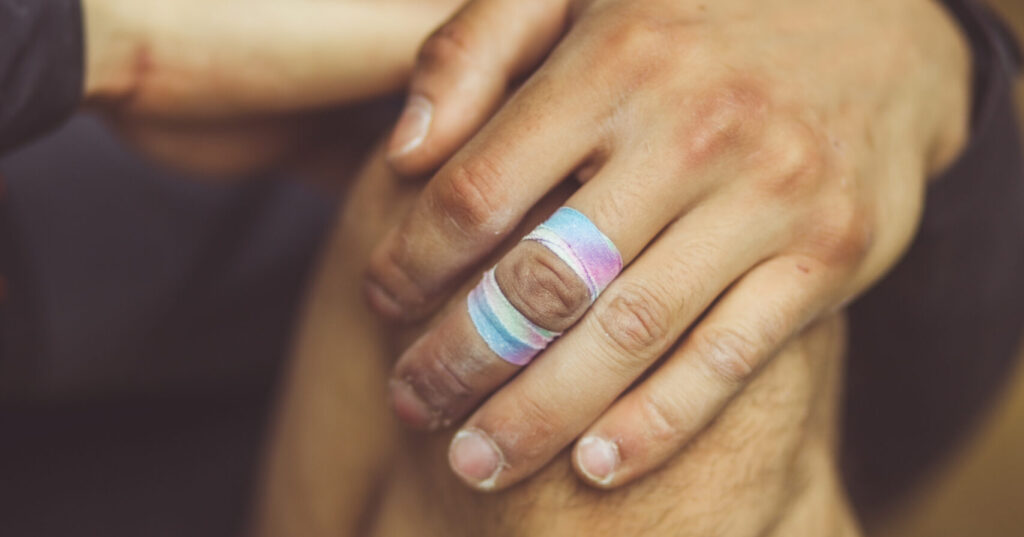Expert Blog
Understanding your skin
Your hands connect you to the wall. But unlike muscles, which get stronger the more you train them, your skin has limits. Understanding how skin works and how climbing affects it is the first step toward keeping your hands in top shape.

Your skin in layers
Your skin is your body’s largest organ. It protects you from the outside world, regulates temperature, and plays an important role in hydration and immune response. Understanding how your skin is built helps you take better care of it, so you can climb more and avoid preventable damage.
Your skin has three main layers:
- Epidermis (outer layer): This is your first line of defence. The epidermis consists of five layers and forms a barrier against friction, chalk, bacteria, and moisture loss. Most climbing-related damage such as splits, abrasions, and calluses occurs here.
Sub-layers of the epidermis:
- Stratum corneum: a protective barrier, made from dead, keratinised cells, where most wear, flappers, and calluses occur
- Stratum lucidum: a transparent layer that adds extra protection to fingertips and palms
- Stratum granulosum: the layer where cells start to die and flatten
- Stratum spinosum: a layer of active cell for structural support
- Stratum basale: a layer where cell division and regeneration occurs
- Dermis (middle layer): Located just beneath the surface, the dermis contains blood vessels, sweat glands, nerve endings, and collagen. If you tear into this layer (like with a deep flapper), healing takes much longer and the risk of infection increases.
- Hypodermis (deep layer): This layer consists mostly of fat and connective tissue. It cushions your body and stores energy. While rarely affected by climbing injuries, extreme trauma (such as deep cuts or crush injuries) can reach this level.
2.3 Common skin types
Not all skin behaves the same. Genetics, hydration, climate, and even nutrition can influence how your skin responds to climbing. Knowing your skin type can help you choose the right chalk, care routine, and recovery products.
Dry skin
- Dry skin is often flaky and prone to splits. It cracks in cold weather when over chalking.
- Needs: Regular hydration with KletterRetter hand cream, fewer filing sessions, time off when you are treating deep splits.
- Avoid: Overuse of chalk or harsh soaps
Oily skin / sweaty palms
- If your hands feel slippery during warm-ups or when nervous and if chalk wears off quickly, you most likely have oily skin and sweaty palms.
- Needs: Liquid chalk or cream chalk, breathable tape, light daily moisturising
- Avoid: Over moisturising before climbing on climbing days
Normal / balanced skin
- Normal skin is quite resilient and it rarely cracks or sweats excessively. Normal skin usually responds well to routine care.
- Needs: Maintenance with KletterRetter hand cream and a skin file. Make sure you plan the occasional rest day.
- Avoid: Complacency, even small injuries need attention
Tough skin / thick callus formers
- Tough skin is a climber’s dream! It builds callus fast and hard, but it can therefore be prone to flappers and edge tears.
- Needs: Regular use of a skin file, proactive taping, balsam for recovery
- Avoid: Letting calluses get too thick. Keep them smooth with a skin file and trim or remove loose skin before the callus tears.
Calluses
When you climb regularly, your skin responds by building calluses. Calluses are essentially thickened skin on your fingertips, palms, and knuckles (and toes). Calluses are a natural protective mechanism, but they can become a liability if not managed correctly.
- Too thin: painful skin, increased risk of flappers
- Too thick: prone to ripping and tearing
- Uneven: hotspots that catch on holds and rip mid-move
Goal: Strong and smooth calluses that can take a beating, without tearing off
The stress on your skin
Different holds, rocks and climbing styles all affect your skin differently. Prolonged compression, shearing (where the layers of your skin move in different directions), friction, pressure and heat can cause damage to your skin.
| Type of hold | Stress to skin | Common effects |
|---|---|---|
| Crimps | Compression and shearing | Split fingertips and calluses on the edges of your fingers |
| Slopers and piches | Friction | Surface wear, thin skin and abrasions |
| Pockets | Pressure | Deep splits and damage to fingernails and nail beds |
| Jugs | Friction and shearing | Calluses, blisters and possibly flappers on your palms and fingers |
| Hangboards | Heat and shearing | Surface wear and thin skin |
Environmental factors like humidity, temperature, and hold texture also play a big role. For example:
- Cold temperatures can cause brittle skin and a higher risk of splits
- Heat and sweat cause softened skin and more friction injuries
- Indoor climbing holds are often smoother but often involve repetitive friction
- Outdoor climbing holds are rougher but more variable
2.6 Moisture and hydration
Moisture is critical for healthy skin, but it’s also a balancing act:
- If your skin is too dry, it will be more prone to cracks and splits as it becomes brittle
- If your skin is too moist, your skin softens which in turn increases friction and the likelihood of a flapper
This is why good skin care isn’t just about repairing damage. It’s about managing hydration and texture over time. We will go into more detail on how to manage your skin in the next two chapters.
Important concept: Healthy climbing skin is tough, flexible, and well-conditioned, not dry, soft, or overly hardened.
2.7 The role of recovery
Skin doesn’t get stronger from climbing alone. It gets stronger during rest, just like muscles and needs time to rebuild. After heavy climbing, the stratum corneum and upper skin layers of the epidermis can take 48–72 hours to fully regenerate. Ignoring recovery time can result in chronic skin fatigue, where chalk no longer sticks, splits happen more easily, and your hands never feel ready.
What you can do is:
- Support the recovery process, with a customised skin care routine – see chapter 4
- Reduce the damage caused by friction, with the right use of tape and chalk
- Condition your skin daily with skin care products, skin files and nail clippers
- Support blood flow, with acupressure rings and hand training tools
- Stay hydrated b



